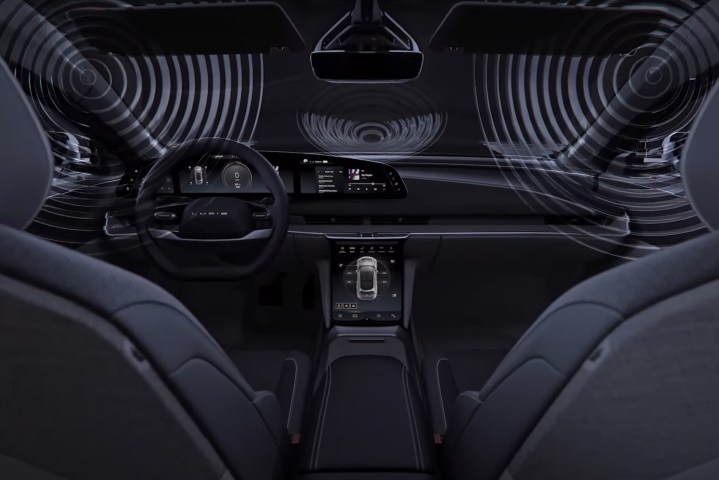
March 2021 is, apparently, a big month for car audio. Audi kicked things off with its announcement that its 2022 Q4 E-Tron will be the first vehicle with a Sonos-tuned sound system, then McIntosh trumpeted its return to car audio with the 2022 Jeep Grand Wagoneer, and now Dolby Labs is taking the wraps off of a partnership with Lucid Motors that will make the Lucid Air the first car to feature a Dolby Atmos sound system.
It’s a 21-speaker, 800-watt, dual-amplifier system that Lucid has dubbed “Surreal Sound.” It will be standard equipment in every Lucid Air Dream Edition and Grand Touring trim models, and optional equipment for the Touring and Pure trim levels.
Those 21 speakers have been arranged around the interior of the cabin using a similar layout to a home theater, with front, rear, side, and height channels. According to Lucid Motors, it worked with Dolby, to tune the speaker system for the space of the Lucid Air using the Capitol Records Studio C recording studio as the reference design.
The result is a sound system that can reproduce Dolby Atmos sound, using a 12-channel, 7.1.4 Atmos configuration. Most folks will be familiar with Dolby Atmos from commercial or home movie theaters. It’s the surround sound technology that gives movies a 3D quality, allowing sounds to move about the room from any direction, independent of each other. The classic example is hearing a helicopter roar overhead as it moves from in front of the viewer’s seat to behind them.

But in the case of the Lucid Air, it’s Dolby Atmos Music that takes center stage. Music that has been produced using Dolby Atmos Music technology can take advantage of that same immersive, 3D quality, but it tends to uses these effects more subtly, to place listeners in the middle of a performance.
“From reimagined classics to some of today’s biggest chart-topping hits, Dolby Atmos Music has been positively embraced and viewed by the music community as one of the industry’s biggest paradigm shifts within the past 50 years,” said Tim Pryde, Director of Music, Dolby Laboratories, in a press release.
The Lucid Air will be equipped with the ability to stream music from services that support the Dolby Atmos Music format, though we don’t yet know which of these services will be included. The system is also compatible with Apple CarPlay, Android Auto, and hi-res audio.
Lucid Motors intends to use the Surreal Sound system for more than just 3D music. It will enable “acoustic signaling” of notifications, indications, warnings, and all other audio emitted to alert the driver and passengers, by having those sounds appear to come from the relevant area of the interior.
Lucid offered several examples: “A seatbelt warning will, to the driver’s ears, come from the direction of the unbuckled belt. Other warnings, such as blind-spot detection, will feature directionality to help focus the driver’s attention. Even sounds as common as turn signals will sound to the driver as if it were coming from the indicated side of the vehicle.”
The Lucid Air, which starts at $77,400 for the Pure Edition, has an EPA-estimated range of 406 miles on a single charge and is available for reservation now. The Grand Touring Edition, which is the least expensive version to come standard with the Surreal Sound system, starts at $139,000. Lucid Motors expects to start delivering vehicles to customers in the second half of 2021.
Correction: An earlier version of this story said that the Surreal Sound system will support services like Tidal, Deezer, and Amazon Music HD, but these have not been confirmed.
Editors' Recommendations
- What is Dolby Atmos Music, and how can you listen to it at home and on the go?
- Dolby’s Vegas flex: in person with FlexConnect and Dolby Atmos in-car
- Samsung’s new Dolby Atmos wireless speaker doubles as a picture frame
- Apple’s Dolby Atmos Music bounty could be a disaster for the format
- Samsung, Google are attacking Dolby Atmos’ monopoly on 3D sound, and it’s going to get ugly




